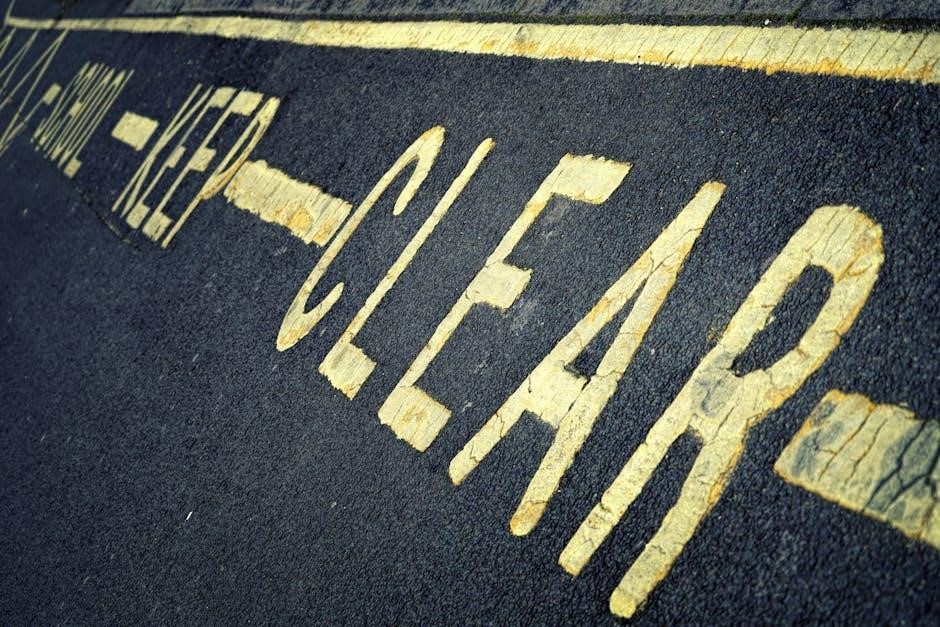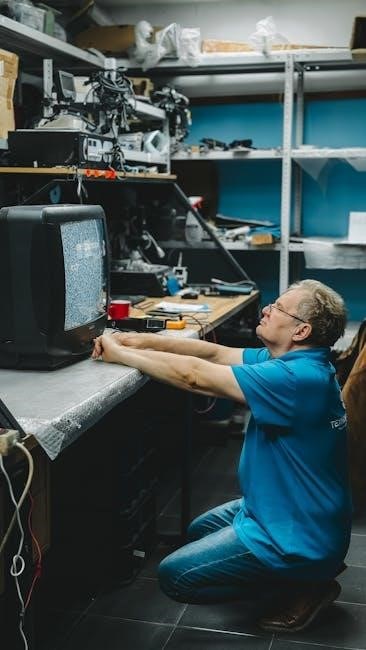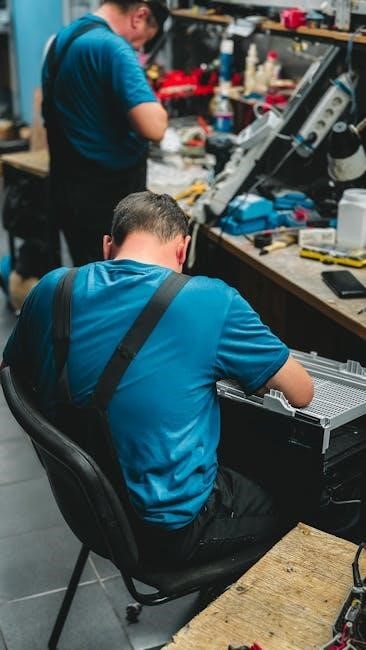Proper pool maintenance is essential for ensuring clean, safe, and enjoyable swimming conditions. A well-structured routine prevents issues and extends equipment life, ensuring safe swimming experiences.
1.1 Importance of Regular Pool Maintenance
Regular pool maintenance is crucial for ensuring a clean, safe, and visually appealing swimming environment. It prevents contamination, reduces the need for costly repairs, and extends the lifespan of pool equipment. By maintaining proper chemical levels and cleaning routines, you can avoid algae growth, cloudy water, and harmful bacteria. Consistent upkeep also enhances swimmer safety, making it essential for protecting health and enjoyment. A well-maintained pool not only saves time and money but also provides a refreshing and hygienic space for recreation.

1.2 Overview of Pool Maintenance Tasks
Pool maintenance involves a combination of daily, weekly, and seasonal tasks to keep the water clean and safe. Daily routines include skimming the surface and brushing pool walls to remove debris and prevent algae growth. Weekly tasks involve shocking the pool to oxidize contaminants and cleaning the filter. Seasonal maintenance includes opening and closing the pool, balancing chemicals, and ensuring equipment functionality. Consistent upkeep prevents contamination, extends equipment life, and ensures a safe, enjoyable swimming environment. Proper tools and adherence to safety guidelines are essential for effective maintenance.

Daily Pool Maintenance Routine
Daily pool maintenance includes skimming debris, brushing walls, cleaning skimmer baskets, checking chemical levels, and ensuring the pump operates efficiently for clean, safe water conditions.

2.1 Skimming and Brushing the Pool
Skimming the pool surface 2-3 times weekly removes floating debris, preventing it from sinking and causing contamination. Brushing the walls and floors regularly helps eliminate algae buildup and maintains a clean appearance. Use a pool brush to scrub stubborn spots, especially in corners where dirt accumulates. This routine ensures water clarity, prevents staining, and maintains hygienic conditions for swimmers. Neglecting these steps can lead to cloudy water and increased chemical demand, making maintenance more challenging over time.
2.2 Checking and Adjusting Chemical Levels
Regularly testing and balancing pool chemicals is crucial for maintaining clean, safe water. Check pH, chlorine, and alkalinity levels daily using a reliable test kit. Adjustments should be made to ensure pH levels are between 7.2 and 7.8, and chlorine levels are between 1 and 3 ppm. Proper chemical balance prevents eye irritation, protects equipment, and ensures effective sanitation. Imbalanced levels can lead to cloudy water, algae growth, or equipment damage, making routine checks essential for optimal pool conditions and swimmer safety.

Weekly Pool Maintenance Tasks
Weekly tasks include shocking the pool to oxidize contaminants, cleaning the filter, and skimming the surface. These steps ensure water clarity and equipment efficiency.
3.1 Shocking the Pool and Oxidizing Contaminants
Shocking the pool involves adding oxidizers to eliminate contaminants like sweat and lotions. This process restores water clarity and prevents algae growth. Perform weekly, using products like Poolife calcium hypochlorite. Apply in the evening to maximize effectiveness. Always follow the manufacturer’s instructions for proper dosage. After shocking, test the water to ensure safe chlorine levels for swimmers. Regular shocking maintains a clean, healthy environment and prevents future maintenance issues.
3.2 Cleaning the Pool Filter and Cartridge
Regularly cleaning the pool filter and cartridge is crucial for maintaining water circulation and clarity. Use a garden hose to rinse debris from the cartridge. For deeper cleaning, soak it in a mixture of water and filter cleaner. Replace the cartridge as recommended by the manufacturer. A clean filter improves pool efficiency, reduces chemical demand, and ensures safe swimming conditions. Always turn off the pump before cleaning to avoid damage or injury.

Seasonal Pool Maintenance
Seasonal pool maintenance is crucial for preparing your pool for opening and closing. It ensures equipment longevity, prevents damage, and maintains safe swimming conditions year-round.
4.1 Opening the Pool for the Season
Opening your pool for the season involves several key steps to ensure it’s clean and safe. Start by removing the pool cover and cleaning it thoroughly. Inspect the pool and surrounding area for debris and damage. Reinstall any winter plugs and prime the pump. Test the water chemistry and balance the pH, alkalinity, and chlorine levels. Shock the pool to oxidize contaminants and add algaecide to prevent algae growth. Finally, run the filter continuously for 24-48 hours to clarify the water before use.
4.2 Closing the Pool for Winter
Closing your pool for winter requires careful preparation to protect it from freezing temperatures and contamination. Start by removing debris and lowering the water level below the skimmer. Drain all equipment, including pumps and heaters, to prevent freezing. Add winterizing chemicals to stabilize the water and prevent algae growth. Install a durable pool cover to keep out leaves and dirt. Regularly inspect the cover and perform maintenance as needed to ensure your pool remains in great condition until spring.
Chemical Maintenance and Safety
Proper chemical handling and storage are crucial for safety. Always test and balance water chemicals, following manufacturer instructions to ensure a safe and clean swimming environment.
5.1 Testing Water Quality and Balancing Chemicals
Regularly testing water quality ensures safe and clean swimming conditions. Check pH, chlorine, and alkalinity levels, adjusting as needed to maintain balance. Imbalanced chemicals can cause eye irritation or algae growth. Use test kits or strips for accurate readings. Properly dose chemicals according to manufacturer instructions. Algaecides should be added in the morning for best results. Shock treatments help oxidize contaminants. Keep records of water quality tests to track trends and maintain optimal conditions year-round.

5.2 Understanding Chlorine, Algaecides, and Stabilizers
Chlorine is essential for sanitizing pool water, effectively killing bacteria and oxidizing contaminants. Algaecides prevent algae growth, ensuring clear and safe water. Stabilizers, like cyanuric acid, protect chlorine from sunlight degradation, maintaining its effectiveness. Proper levels of these chemicals are crucial for safe swimming conditions. Understanding their roles and interactions is key to effective pool maintenance and preventing issues like cloudy water or sanitize inefficiency.
Troubleshooting Common Pool Issues
Identifying and addressing pool issues early prevents major problems. Regular water testing and equipment checks help detect imbalances or malfunctions. Addressing cloudy water, algae growth, or equipment failure promptly ensures safe and clean swimming conditions.
6.1 Dealing with Algae Growth and Cloudy Water
Algae growth and cloudy water are common pool issues that require prompt attention. Algae can develop due to insufficient chlorine levels, excessive sunlight, or poor circulation. Regular testing of chlorine levels and maintaining proper chemical balance are crucial. Using algaecides specifically designed for the type of algae present can effectively treat infestations. Cloudy water often results from dirt, contaminants, or imbalanced chemicals. Shocking the pool, which involves adding oxidizers to eliminate contaminants, can help clarify the water. Preventing future issues involves consistent maintenance routines, including brushing pool walls to prevent algae attachment and ensuring adequate filtration. Regular water testing and adjusting chemical levels as needed are essential for maintaining clear and safe swimming conditions.
6.2 Fixing Leaks and Equipment Malfunctions
Identifying and repairing leaks promptly is crucial to prevent water loss and equipment damage. Inspect pipes, fittings, and valves for cracks or gaps. Use sealants or replace damaged parts as needed. For equipment malfunctions, check the pump, filter, and heater for issues. Regularly cleaning the skimmer and pump basket ensures proper water flow. Addressing these problems early prevents costly repairs and ensures efficient pool operation. Always follow manufacturer guidelines for equipment maintenance and repair.
Safety Tips for Pool Maintenance
Proper handling of chemicals and equipment is vital for safety. Always wear protective gear, supervise children, and ensure the pool area is slip-resistant and well-lit. Keep emergency equipment nearby.
7.1 Proper Handling of Chemicals and Equipment
Always wear protective gear like gloves and goggles when handling pool chemicals. Read labels carefully and follow instructions to avoid accidents. Store chemicals in a cool, dry place, away from children and pets. Never mix different chemicals, as this can create dangerous reactions. Keep the pool area clear of clutter to prevent tripping hazards. Regularly inspect equipment for damage or wear and tear to ensure safe operation. Proper handling ensures safety and effectiveness in maintaining your pool.
7.2 Ensuring a Safe Swimming Environment
Regular water testing ensures balanced chemical levels, preventing eye irritation or infections. Supervise children and inexperienced swimmers to avoid accidents. Keep the pool area clean and free from slipping hazards. Install fencing and gates to restrict unauthorized access. Post safety rules and emergency contact information nearby. Maintain proper lighting for visibility, especially at night. Always have a first aid kit and emergency equipment, like a rescue tube, readily available. A safe environment promotes enjoyable swimming experiences for everyone.
Recommended Tools and Supplies
- Skimmers for removing surface debris.
- Brushes to clean pool walls and floors.
- Test kits to monitor water chemistry.
- Pool covers to prevent contamination.
- Vacuums and filters for deep cleaning.
- Chemicals like chlorine and algaecides.
- Pool shocks to oxidize contaminants.
- Gloves and goggles for protection.
8.1 Essential Equipment for Pool Maintenance
Essential equipment for pool maintenance includes skimmers, brushes, and vacuums to keep the pool clean. Test kits are crucial for monitoring water chemistry, while filters and pumps ensure proper circulation. A pool cover prevents debris accumulation, and shock treatments help oxidize contaminants. Chemicals like chlorine and algaecides maintain water safety and clarity. Additionally, gloves and goggles protect during maintenance. These tools ensure efficiency and effectiveness in keeping your pool pristine.
8.2 Where to Find Reliable Pool Maintenance Resources
Reliable pool maintenance resources can be found in pool maintenance guide PDFs, available on trusted websites like Amazon or manufacturer sites. Local pool supply stores often provide expert advice and materials. Online forums and communities share practical tips and recommendations. Libraries may also carry detailed manuals. Always verify credibility by checking reviews or relying on established brands. These resources ensure you have the knowledge and tools needed for effective pool care.